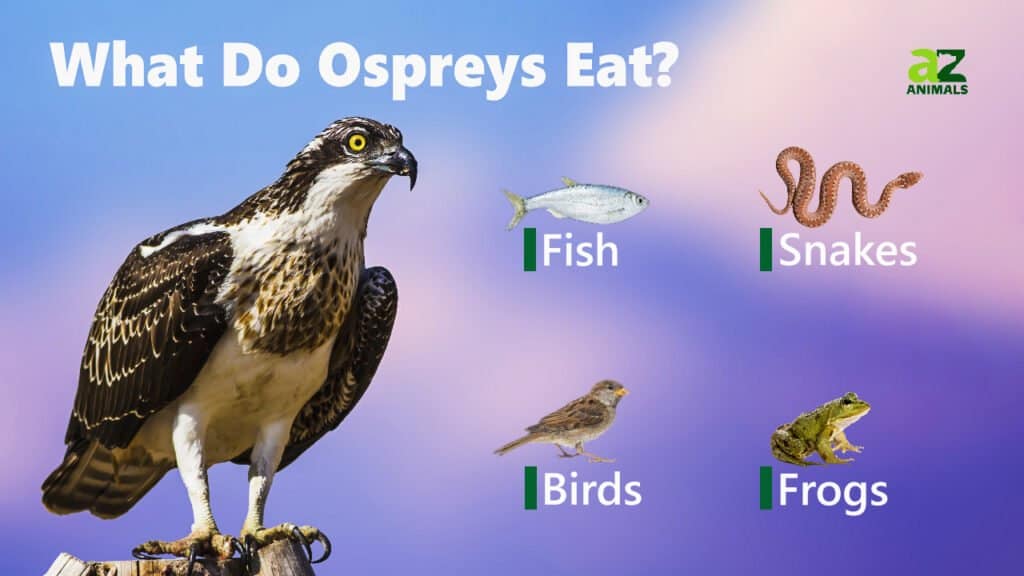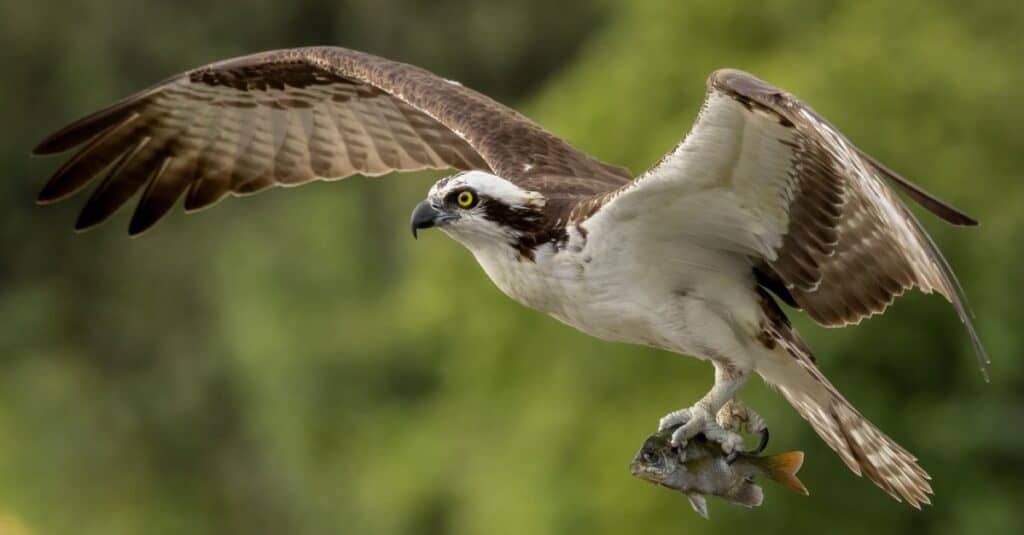Ospreys are large raptors (predatory birds) that live across much of the world. They are commonly referred to as sea hawks, river hawks, and fish hawks, showing their preference for aquatic habitats with plenty of fish. Ospreys have white or gray chests and necks, with brown wings and backs. Their sharp hooked beaks are perfect for tearing into prey, and their talons are specially designed to catch slippery fish. Let’s take a look at some of the things that ospreys eat, plus some of the things that make them the incredible hunters that they are.
What do ospreys eat?

Ospreys are phenomenal hunters, but their diet is rather unique among the other raptors they live in proximity to. They are piscivorous, meaning ospreys eat diets consisting mainly of fish. Their different names make sense in light of their specialized diet! Generally, it doesn’t matter the type, species, or size of fish, an osprey will eat it all!
On average, an osprey will kill and eat fish averaging 10-14 inches in length and up to 10 oz, or a little over half a pound. Still, ospreys aren’t picky and will eat anything they are physically able to lift out of the water. They will also hunt in freshwater and saltwater habitats.
Although 99% of an ospreys diet is made up of fish, they will occasionally prey on other small mammals and reptiles. Most of their non-fish prey come from small mammals and rodents, but other birds and reptiles are occasionally on the menu.
A complete list of foods that ospreys eat
Ospreys are known for their nearly entirely fish-based diet, with most getting 99% of their calories from fish. Additionally, they are known to be generalist eaters and don’t care much for the specific type of fish they catch, as long as they can eat it! Still, here is a list of the most common fish that ospreys are likely to eat.
A complete list of foods that ospreys eat:
- flounder
- smelt
- mullet
- bullhead
- sucker
- gizzard shad
- rabbits
- moles
- mice
- rats
- lizards
- small birds
How do ospreys hunt?

Ospreys can catch up to 10 fish a day when feeding chicks.
©iStock.com/Harry Collins
Ospreys are truly some of the best fishers in the world! They have two main advantages that allow them to be so successful in their catches: physical adaptations and behavioral adaptations. Let’s go over both of them separately.
Physical adaptations
There are some amazing evolutionary adaptations that ospreys have developed to suit their fishy diets. One of the most helpful is their reversible outer toes. Generally, a bird of prey has four talons, three in the front and one in the back (think of an eagle or a hawk). Ospreys have developed the ability to rotate one of their toes backward, allowing them to grip with two toes in the front and two in the back. For elongated and slippery fish, this modified grip makes sure they never drop their catch. Additionally, ospreys have sharp spines and rough pads on their feet, adding extra grip. When they grab a fish, the rough pads and sharp spines lock the fish in. As a bonus adaptation, their scales are even backward-facing on their feet, giving them even more grip. It’s safe to say that once an osprey gets hold of a fish, it isn’t getting away!
Outside of their claws, ospreys have closable nostrils. When they dive for their food, they drop into the water, sometimes even sinking their whole bodies. Having nostrils that can close ensure that they never breathe in water by accident. On top of that, their plumage (feathers) are especially thick and oily when compared to other birds of prey. This allows them to shed water as waterfowl would so they don’t get bogged down after making a catch.
Behavioral adaptations
Ospreys are incredibly successful when they hunt. On average, they spend 12 minutes looking for food and are generally successful, catching a fish out of every 4 attempts. In some places, ospreys are even known to have success rates of up to 70%. Let’s see how they do it.
The first thing that ospreys do while hunting is to fly above the water, roughly 30-150 feet high, and look for fish below. When it spots one, it will then hover before plunging towards the water with feet outstretched. What makes the osprey so good is that it adjust its flight angle as it dives to account for the water’s refraction of the fish. This adjustment makes them much more accurate.
Once it hits the water, the osprey will close its nostrils, grab the fish, and then head to a nearby perch to eat.
What animals compete with ospreys for food?

An ospreys main competitor is the eagle. Eagles are larger and more powerful than ospreys, but eat the same prey.
©FloridaStock/Shutterstock.com
The main competitor for ospreys is eagles. Eagles generally fill similar niches as ospreys do, catching fish and staying near water. On top of diet, eagles and ospreys are both diurnal, meaning they are active and hunting at the same time during the day. Eagles are generally bigger than ospreys, and confrontations are generally eagle-favored.
Where do ospreys live?
Ospreys live almost everywhere on the globe. They are the second most distributed raptor in the world, only behind the peregrine falcon. In North America, they are found as far north as Alaska and as far south as Florida. It winters even further south, venturing as far as Argentina in the Western world. In Europe, it is found from Ireland through Scandanavia and all the way south through most regions of Africa. They are also found in Australia and are uncommonly known to winter in South Asia. Depending on the time of year, ospreys can be found through every continent save Antarctica.
The photo featured at the top of this post is © LMIMAGES/Shutterstock.com
Thank you for reading! Have some feedback for us? Contact the AZ Animals editorial team.







